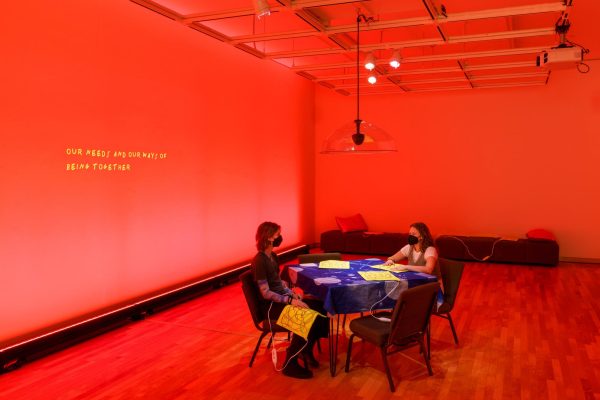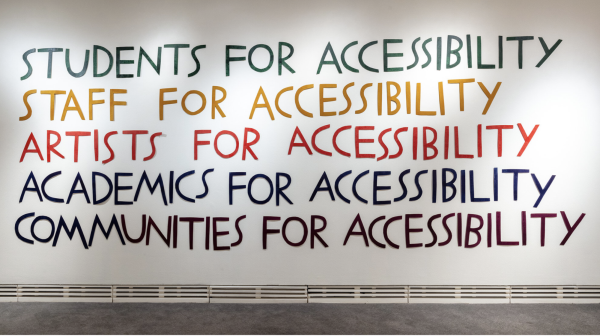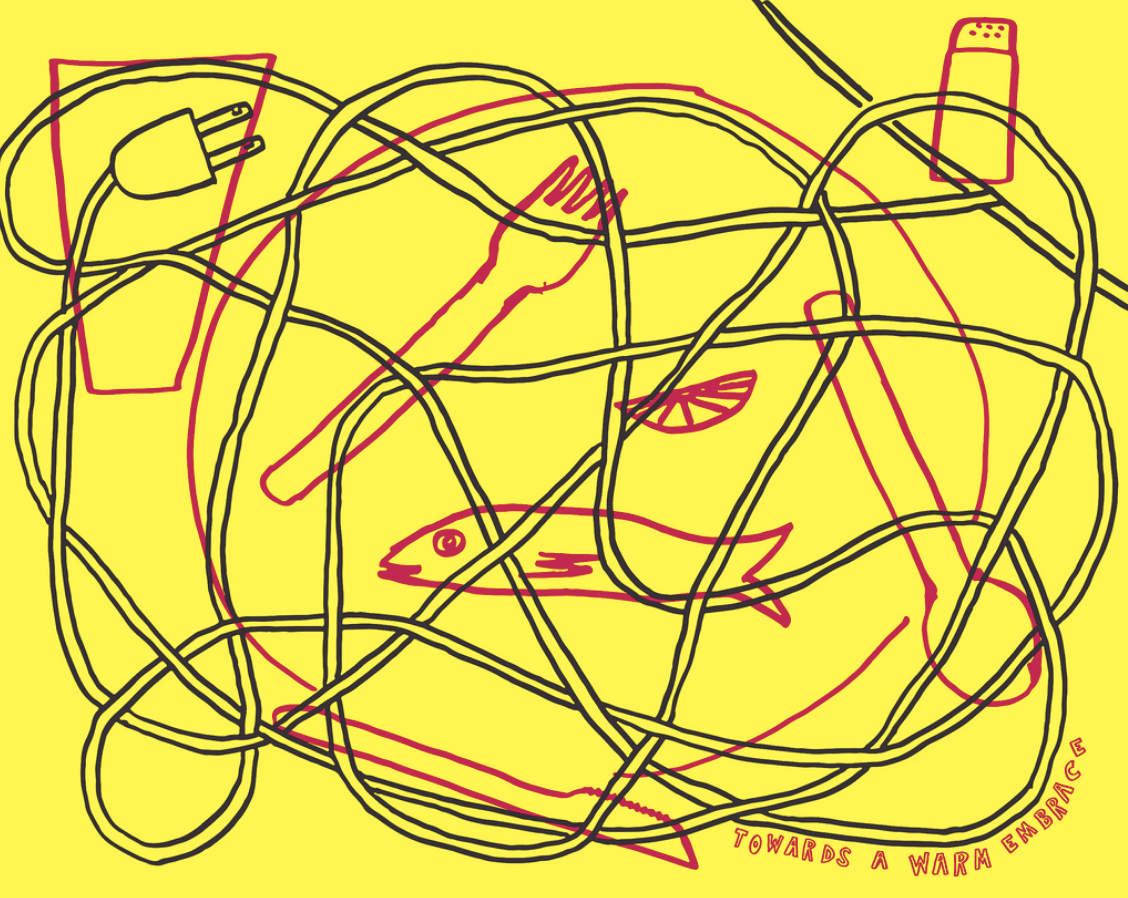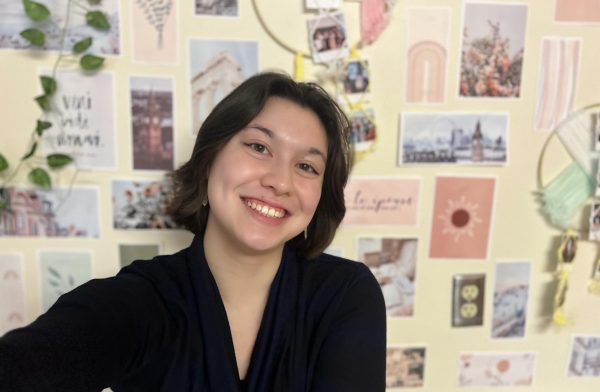Last Thursday, Jan. 11 from 5-7 p.m. in the Weitz Center for Creativity, a new exhibition at the Perlman Teaching Museum was unveiled. Titled “Towards a Warm Embrace,” this event featured a talk with artists Finnegan Shannon ’11 and Ezra Benus in the Weitz Center Cinema, followed by an opening reception for the show. It will run until April 24, 2024.
“A central table, some really comfy benches, and some heating pads scattered around the room,” said Sara Cluggish, the Mary Hulings Rice Director and Curator of the Perlman Teaching Museum, to describe “Hot Hang,” an installation in the show. “You’re invited to come in, use a heating pad, and be in the space however feels good and comfortable for you. It’s a great exhibition for the winter.”

“Hot Hang” is the product of Shannon and Benus’s collaboration centering on themes of shared warmth and open accessibility, a theme conveyed through a material object: a heating pad. Located in the smaller room of the museum, visitors are welcome to use said heating pads and benches while listening to the 20-minute audio loop of a conversation between the two artists as they explain the installation’s “origin story.”
As far as the installation’s physical origin story goes, it was commissioned by Cluggish, who considers commissions to be “the most exciting way to work with artists because you’re creating something from nothing all together. It’s exciting and can also be a little nerve-wracking because you don’t know what it’s all going to look like until right before it opens.”
Throughout the installation’s creation, the artists collaborated with Cluggish to design the environment that “Hot Hang” would fill. Various details emerged from these discussions, such as the tinted lighting that establishes the room’s mood and tone. This lighting system, suggested by Cluggish, was eventually produced with the help of theater professor and lighting production manager, Tony Stoeri.
Students from Assistant Professor of Art Jade Hoyer ’07’s printmaking class, were also involved in the creation process. Last fall, they became involved in the screen-printing process, printing the lead image featured on “Hot Hang”’s heating pads, which was designed by Benus and Shannon.
“The students were able to ask some questions about their work, like about [Benus and Shannon’s] artistic collaboration,” said Cluggish. “The students also received a screen-printing of the show’s lead image on acid-yellow paper to take home as their own, to thank them for their time and work.”
Benus and Shannon’s solo artwork, which predate their collaboration, are also on display throughout the rest of the museum. Some of these were chosen by student curators who work for the Perlman Teaching Museum. Cluggish worked with Benus and Shannon to decide the layout of the pieces themselves.
“I know our gallery’s spaces really well. So for instance, I said to Shannon and Benus that the work that we put here can be seen from the foyer, so that is a really important place,” said Cluggish. “A piece that says ‘Students for Accessibility, Staff for Accessibility, Artists for Accessibility, Academics for Accessibility, Communities for Accessibility’ can be read as a call to action that’s directly addressing our audience.”

Many other artworks in the show contain a similar emphasis on text and direct communication with visitors.
“There’s this turn towards text — poetry, conversational text, handwritten text — as a way to directly address viewers in a conversation,” said Cluggish, “around what accessibility means, why it’s important, and to share their perspectives as disabled individuals who are moving through the world.”
On the Perlman Teaching Museum’s end, they have continued to focus on creating more accessible exhibitions, which has recently included various conversations relating to “Toward a Warm Embrace.”
“One important thing is that for this exhibition, we worked with the artists, our student worker team, and staff to write an accessibility statement for the exhibition and events,” explained Cluggish. “Our student workers gave us recommendations about what they thought could make the museum more accessible because they’re the ones on the front lines, sitting in the desk.”
Other efforts to increase visitor accessibility with this show are Masked Mondays, when visitors are required to mask within the museum. The gallery also utilizes larger, 18-point font descriptions for works and a lower hanging of the canvases.
“Another thing that I’d say is unique to this exhibition is that there’s ample seating. That’s a motif that occurs in both the artists’ works,” said Cluggish, “and a lot of the artworks are also interactive. They can be sat on; they can be used as a daybed.”
Some of these changes, while making artworks more accessible to some, may impact other visitors in unintentional ways, such as the lower hanging of canvases.
“There’s a standard that all artworks at a default are hung at, and these [works] are a lot lower. But it’s tricky because…you can’t be all things to everyone. So in putting certain things low, I’m also thinking about our very tall visitors and what might be hard for them,” said Cluggish. “If we have a larger label that goes lower to the ground, then at a certain point, they’re crouching. So I think the key thing is to keep having this conversation [about accessibility] with our audiences, and I say audiences plural because there’s no one audience. People come to art in many different ways.”
Through all of these changes, the museum is emphasizing its continued commitment to creating more accessible spaces.
“For this exhibition, we’re introducing some new practices… There are other things that I would be happy to think about, but they’re things that would take more staff time and resources. It’s balancing the many things that can be done with what our community actually needs,” said Cluggish. “What can we commit to doing and carrying that practice on into the future, so that it’s not just a one-off gesture because this show is about accessibility and then it goes away? That was really important to us as a team.”
Upcoming events relating to “Towards a Warm Embrace” include the convocation on Jan.19 with Jerron Herman as well as touch tours on Jan. 24 from 4:30-5:30 p.m. and Feb.15 from 5-6 p.m.. These tours will focus on sensorial interactions with the artwork through multiple senses.
“[Exhibitions] are kind of a constellation of artworks. Artworks here will never come together again in the same configuration, so it’s very ephemeral,” said Cluggish, “and at the end of the show, they’ll all be packed up and taken to their respective homes, so come see the show!”













